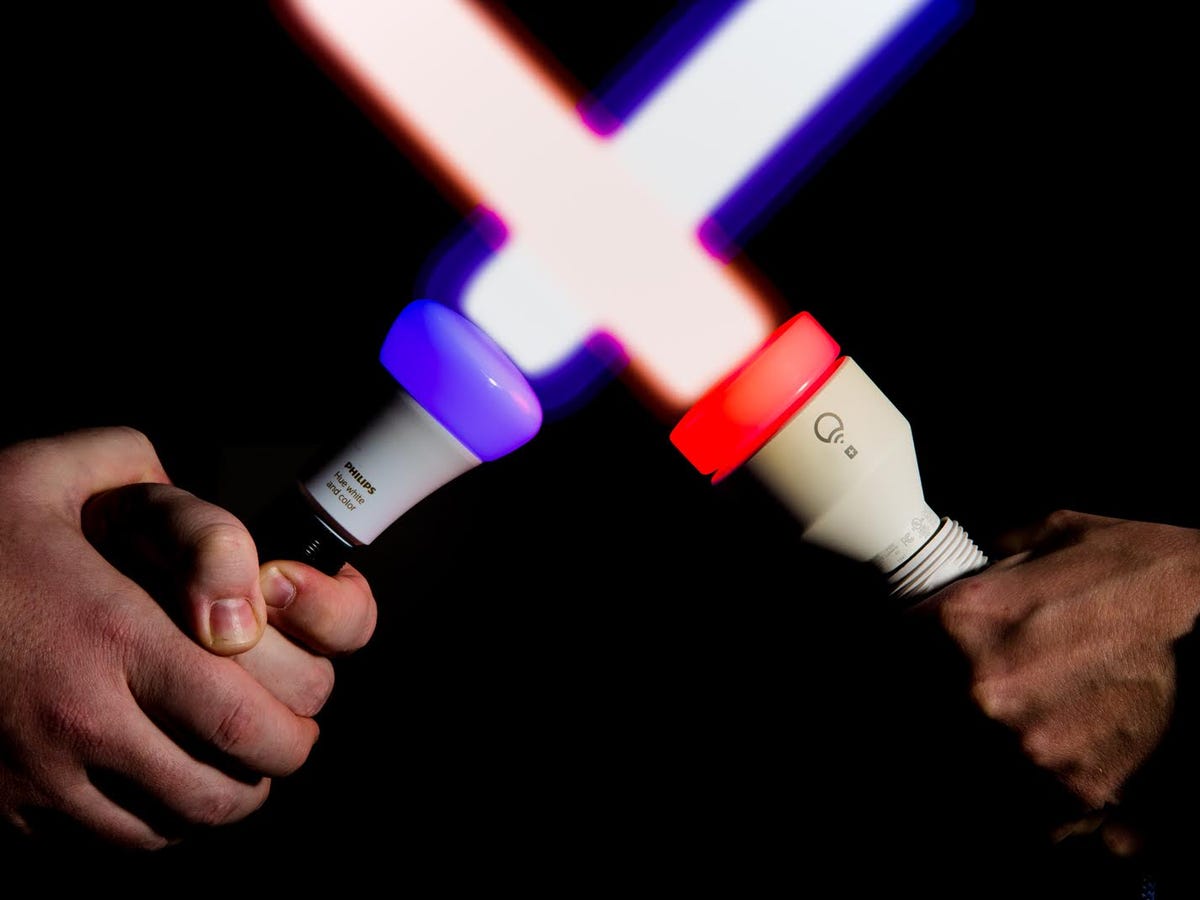Clash of the color-changing bulbs: Philips Hue vs. Lifx
It's time for a face-off between the two biggest names in the color-changing smart bulb game. Who've you got?

If you're thinking of splurging on color-changing options, your top two options are Philips Hue (left) and Lifx (right). Both are well-developed product lines with multiple generations of hardware under their belts, both have the color-changing smarts you're likely looking for and both are still really expensive.
That means if you're thinking about buying in, you'll want to be sure to choose wisely. In that spirit, here's a smart home showdown between the two -- which color-changing bulb comes out on top?
The reigning champ
Our first color-changing contender: the Lifx Wi-Fi LED. A year ago, we called the second-gen Lifx Color 1000 LED the best color-changing bulb money can buy, but a lot's changed since then. Its new, third-gen bulbs are even brighter than before, with a starting price of $60 a piece (about £45/AU$80).
The challenger
In the other corner: Philips Hue. It's the biggest name in color-changing bulbs, and a legitimate smart home heavyweight, complete with Siri-friendly Apple HomeKit compatibility. And, like Lifx, it now boasts new and improved third-gen bulbs.
Hue 3.0
Those new third-gen Hue bulbs claim brighter, bolder colors than before.
Better greens
The most notable improvement? More accurate shades of green. The old Hue bulbs could barely muster anything greener than a tennis ball-looking shade of yellow. With generation three, that's fixed.
Comparison time
Here are those new third-gen bulbs in a head-to-head challenge. That's Hue on the left and Lifx on the right, and at every shade we tested, Lifx was the brighter option.
Beyond the bulb
Both brands offer more than just bulbs. Take these Philips Hue Lightstrips, for instance.
Lifx Z
Lifx has light strips, too. You can even program them to put out multiple colors at once.
Floodlights, too
Both brands offer floodlight options for recessed light fixtures, too.
Hue Go
Philips has the wider range of offerings. Take the battery-powered, cereal bowl shaped Philips Hue Go, for instance. Lifx doesn't offer anything like it.
Hue Beyond
The same goes for Philips' Hue Beyond light fixtures.
Motion sensor
Philips also offers a number of control accessories that Lifx can't match. The most recent? This Philips Hue Motion Sensor.
Switches, too
Philips also offers stick-up smart switches that can pair with multiple bulbs at once. Lifx doesn't offer anything of the sort.
Hue's platform
On top of that, Philips Hue is a very strong lighting platform in its own right. It works with just about anything, it can control third party Zigbee bulbs and it also offers $15 white light smart bulbs (roughly £10, AU$20), making it relatively inexpensive to build out your lighting setup.
Tricky bulbs
Lifx has a few unique tricks up its sleeve, though. Its newest bulb, the Lifx Plus LED, puts out invisible infrared light when the bulb is switched off. Why would you want that? Why, to help your night vision cameras see in the dark, of course!
See for yourself
The CNET Smart Apartment's night vision camera feed in the middle of the night, with and without a Lifx Plus screwed into the lamp in the back of the room. To the camera, it looks as if the lamp is on.
Let's talk apps
The Lifx and Philips Hue apps take different approaches to the way you select colors. The Lifx color wheels are more precise and easier to use.
Scheduled lighting changes
Both apps will let you create scheduled lighting changes. Philips has a more polished look, but the Lifx controls go a little deeper.
Windows app
Beyond the Android and iOS apps, Lifx also offers an app for Windows devices.
IFTTT compatibility
Both Lifx and Hue are compatible with the free online automation service, IFTTT. Sync up with IFTTT and you'll be able to trigger either bulb using a wide variety of compatible products as well as services.
Lifx for the win
Of the two IFTTT integrations, Lifx is more powerful. Just take a look at this "Turn on lights" actions for Philips Hue and Lifx LEDs: the Lifx controls go a lot deeper.
Amazon Alexa compatibility
Both bulbs are also compatible with Amazon's Alexa for voice-activated lighting changes. Lifx gets a slight edge here, because it offers a custom Alexa skill that can change the colors of your bulbs. With Hue, you can only turn bulbs on and off or dim them up and down.
Other integrations
Aside from the more major integrations, both bulbs do a good job of offering compatibility with a wide number of smaller smart home gadgets. They'll both work with the Beddi Smart Alarm Clock, for instance.
Hue works with Siri
However, Hue strikes back with a huge feather in its cap: Apple HomeKit compatibility. That lets you control the bulbs -- including the colors -- using Siri commands. Lifx can't do that, at least not until February, when newly announced HomeKit-compatible Lifx bulbs will hit the market. Until then, advantage: Hue.
Winner: Lifx
Still, our overall winner remains the same, and that's the Lifx Wi-Fi LED. It's much brighter than Philips Hue at every key setting, and the colors look fantastic. It also boasts the slightly better app, along with deeper integrations with IFTTT and Alexa. And, since the bulbs connect directly with your home network over Wi-Fi, you don't need a hub, which makes it an easier option to get started with than Philips Hue. If you can forgive the lack of HomeKit compatibility (at least until February), Lifx is the best color-changing bulb on the market.

